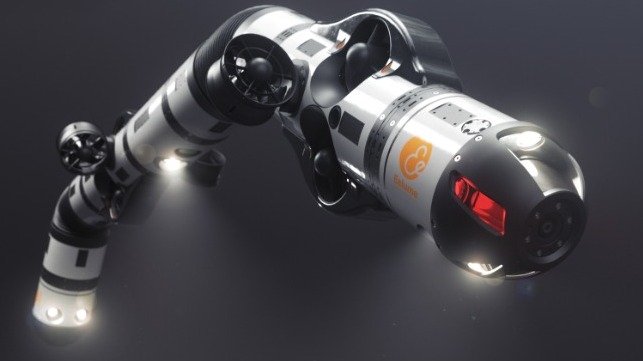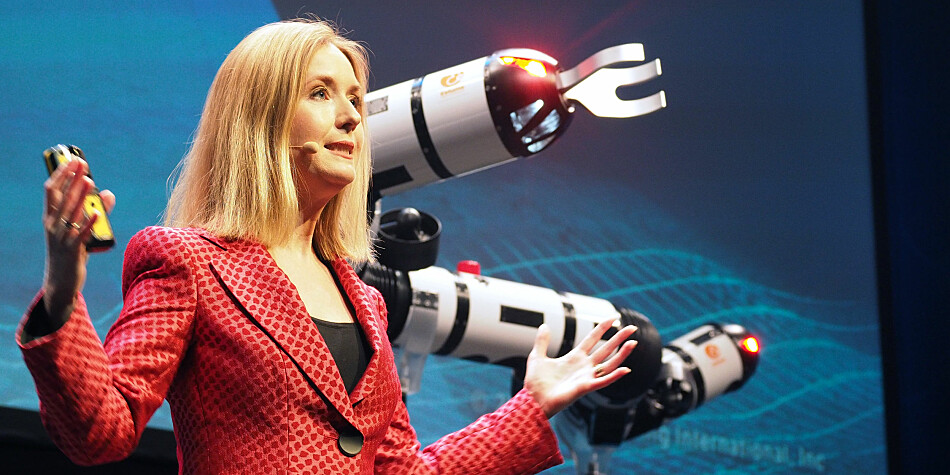
The Maritime Executive
When the Norwegian production company Fantefilm searched the internet to find the coolest underwater robot in the world, they discovered to their surprise that it was being manufactured in Norway. The robot has thus become the first to land a movie role in the film North Sea, which is premiering now.
Kristin Ytterstad Pettersen, professor of engineering cybernetics and one of the key researchers at the Centre for Autonomous Marine Operations and Systems, AMOS, has been studying snake robotics for a number of years. Pål Liljebäck took his doctorate in snake robotics with Pettersen as his supervisor. Based on their research, they started the company Eelume (pronounced ‘ee-loom’) in 2015 as a spin-off from NTNU.
No one could have imagined then that Eelume would land a heroic role in Norway’s largest film production seven years later.
Derived from differential equations
The movie world isn’t the only place where snake robots can be heroes. In the real world, snake robots also play a crucial role.
Underwater robots can help to explore the ocean, for example. “Only five per cent of the ocean has been mapped. A snake robot could help investigate large undiscovered areas, such as the sea under the Arctic and Antarctic,” says Pettersen.
Professor Kristin Pettersen. Photo: Per Henning, NTNU
How does a creature like this come about? The world’s most advanced snake robot for use underwater was first developed through many long math problems that Pettersen and her research group wrote out by hand. When the professors at NTNU’s Department of Engineering Cybernetics (ITK) set out to create something new, differential equations on paper were a key tool.
“Getting robots to move is super fascinating. We use mathematics as a way to decode the secrets of nature. Math is really a language for understanding and analyzing nature,” says Pettersen.
Can perform various tasks at sea
Pettersen has headed the research that led to a world breakthrough in snake robotics, for which she has won numerous awards. Other groups, including Japan and the USA, have focused mostly on mechatronics – the actual construction of joints and materials. Pettersen and her team concentrated on the “brain,” or the algorithms, for how a snake robot should move.
After completing his doctorate, Liljebäck started as Chief Technology Officer (CTO) at Eelume, becoming responsible for technology development in the company. With the rest of the Eelume team, he has developed Eelume’s snake-shaped underwater robot.
“After six years of enormous effort, Eelume is now getting ready to perform various tasks at sea. Today’s robot is the third generation and in the next few months, it will carry out an autonomous inspection of pipelines,” Liljebäck says.
Autonomous means that the robot can perform tasks on its own, based on a plan without having a person controlling it remotely. Other robots, such as ROVs (Remotely Operated Vehicles), are remotely controlled by a person from land or a boat via a cable. Eelume’s robot operates wirelessly, without any wired connection.
An advanced underwater robot like this can help detect leaks and dangerous problems in underwater installations, warn of spills and pollution or other threats, and also do repairs and maintenance.
“We’ll also join with Equinor to test the robot’s ability to detect leaks, and to measure sound, salt content, temperature and oil in water,” says Liljebäck.
Wireless and using AI
The team at Eelume is working hard to ensure that a snake robot like Eelume will not only consist of beautiful math equations conceived at the university, but will also benefit the world through practical uses.
“Pål has a firm grasp when it comes to mastering advanced mathematical theory and constructing the mechatronics themselves. He builds the snake robots so that they look like real creatures, such as giving them eyes that send information and that almost humanize them. They become personalities. The way he combines a mastery of the theoretical and at the same time has the desire to put it all into practice is truly unique,” says Pettersen.
Since Eelume’s robot operates wirelessly, it can move completely freely in the water. Work is now continuing to develop more and more autonomous operations for the snake robot to perform.
“All cybernetics is really about developing the computer’s “brain” and includes an element of artificial intelligence,” says Pettersen.
In 2016, Kongsberg Maritime and Equinor entered into partnership with Eelume as investor, technology partner and customer. Innovation Norway also contributed financial support through an innovation contract.
This article appears courtesy of NTNU and may be found in its original form here.
The opinions expressed herein are the author’s and not necessarily those of The Maritime Executive.
Credit: Source link




